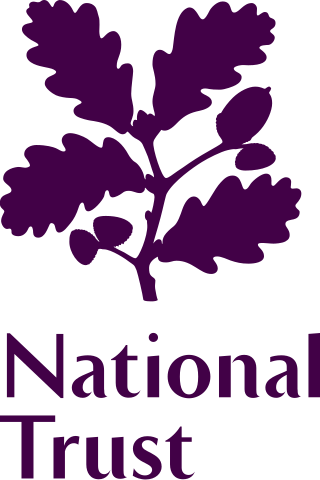
The National Trust is a charity and membership organisation for heritage conservation in England, Wales and Northern Ireland. In Scotland, there is the separate and independent National Trust for Scotland.

English Heritage is a charity that manages over 400 historic monuments, buildings and places. These include prehistoric sites, medieval castles, Roman forts, and country houses.

The Irish Georgian Society is an architectural heritage and preservation organisation which promotes and aims to encourage an interest in the conservation of distinguished examples of architecture and the allied arts of all periods across Ireland, and records and publishes relevant material. The aims of this membership organisation are pursued by documenting, education, fundraising, grant issuance, planning process participation, lobbying, and member activities; in its first decades, it also conducted considerable hands-on restoration activities.
Property management is the operation, control, maintenance, and oversight of real estate and physical property. This can include residential, commercial, and land real estate. Management indicates the need for real estate to be cared for and monitored, with accountability for and attention to its useful life and condition. This is much akin to the role of management in any business.
The Landmark Trust is a British building conservation charity, founded in 1965 by Sir John and Lady Smith, that rescues buildings of historic interest or architectural merit and then makes them available for holiday rental. The Trust's headquarters is at Shottesbrooke in Berkshire.
An Taisce – The National Trust for Ireland, established on a provisional basis in September 1946, and incorporated as a company based on an “association not for profit” in June 1948, is a charitable non-governmental organisation (NGO) active in the areas of the environment and built heritage in the Republic of Ireland. It considers itself the oldest environmental and non-governmental organisation in the country, and is somewhat similar to the National Trust of England, Wales and Northern Ireland but based more directly on the National Trust for Scotland. Its first president was the prominent naturalist Robert Lloyd Praeger.

Taxation in Ireland in 2017 came from Personal Income taxes, and Consumption taxes, being VAT and Excise and Customs duties. Corporation taxes represents most of the balance, but Ireland's Corporate Tax System (CT) is a central part of Ireland's economic model. Ireland summarises its taxation policy using the OECD's Hierarchy of Taxes pyramid, which emphasises high corporate tax rates as the most harmful types of taxes where economic growth is the objective. The balance of Ireland's taxes are Property taxes and Capital taxes.

Hastings Pier is a public pleasure pier in Hastings, East Sussex, England. Built in 1872 and enjoying its prime in the 1930s, it became a popular music venue in the 1960s. The structure suffered major storm damage in 1990, and was closed to the public for a time before closing completely in 2008, and 95% destroyed by a fire in 2010. Hastings Pier Charity oversaw a rebuilding project, with the pier reopening on 27 April 2016. The redeveloped pier won the 2017 Stirling Prize for architecture.
The New York State Housing Finance Agency (HFA) is a New York State public-benefit corporation created in 1960 to build and preserve affordable multifamily rental housing throughout New York State. HFA sells bonds and uses the proceeds to make mortgages to affordable housing developers.
The Institute of International and European Affairs is an Irish policy think tank focusing on European and international policy trends based in Dublin, Ireland. It is known for its seminars and speaking events which attract notable international figures.

The New York Landmarks Conservancy is a non-profit organization "dedicated to preserving, revitalizing, and reusing" historic structures in New York state. It provides technical and financial skills to owners of historic properties. In the half century since its 1973 founding, the conservancy has provided more than $60 million in grants and loans.
The Wiltshire Historic Buildings Trust is a charitable organisation which works to preserve the architectural heritage of Wiltshire, in the West of England.

The Canal & River Trust (CRT), branded as Glandŵr Cymru in Wales, holds the guardianship of 2,000 miles of canals and rivers, together with reservoirs and a wide range of heritage buildings and structures, in England and Wales. Launched on 12 July 2012, the Trust took over the responsibilities of the state-owned British Waterways in those two places.

Aldborough House is a large Georgian house in Dublin, Ireland. Built as a private residence by 1795, the original structure included a chapel and a theatre wing.

Clomantagh Castle is a 15th-century tower house located near Freshford, County Kilkenny, in Ireland. Originally constructed in the 1430s, additional buildings and outbuildings were added in the subsequent centuries - including a connected 19th century farmhouse. Carvings on the castle's walls include a Sheela na gig relief.

The Harley Clarke Mansion consists of a French Eclectic-style house and coach house located at 2603 Sheridan Road in Evanston, Illinois, adjacent to the historic Grosse Pointe Light and Lighthouse Beach on Lake Michigan. Cited as a contributing structure for the Northeast Evanston Historic District that Evanston established with the National Park Service in 1999, it is listed on the National Register of Historic Places.

Affordable housing is housing that is deemed affordable to those with a median household income as rated by the national government or a local government by a recognized housing affordability index. A general rule is no more than 30% of gross monthly income should be spent on housing, to be considered affordable as the challenges of promoting affordable housing varies by location.

The Charities Regulator is the operational name of the Charities Regulatory Authority, the statutory authority responsible for the regulation of charities in Ireland. The organisation is made up of a board, with four sub-committees, and as of 2019, a staff of 38, including a chief executive.

Tailors' Hall is the oldest of two surviving guildhalls in Dublin, Ireland. It is located on Back Lane, off High Street, in the part of the city known as the Liberties. Aside from meetings of its own and many other of the guilds of Dublin, the hall has hosted many social, cultural and educational events. It has been used as a court-house, a barracks, a school, a place of worship and in place of Dublin's City Hall. It was also a meeting place of the United Irishmen, and the site of the Back Lane Parliament. The Tailors' Guild having fully released it by 1873, the building hosted a Christian Mission and later the Legion of Mary. The building having become uninhabitable by the mid-20th century, the Irish Georgian Society launched a restoration campaign in 1966, and it was reopened in 1971. It now holds the headquarters of Ireland's national heritage charity, An Taisce, and can be visited, and rented for events.

Turnberry Lighthouse. or Turnberry Point Lighthouse, is a category B listed minor light on the South Ayrshire coast of Scotland. It was designed by David and Thomas Stevenson and completed in 1873. It is a conspicuous landmark from the Ayrshire Coastal Path and the Trump Turnberry golf resort.
















